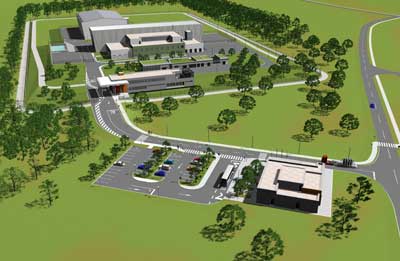
European
Nuclear Society
e-news
Issue 27 Winter 2010
http://www.euronuclear.org/e-news/e-news-27/slovenia.htm


The outline design of the repository has already been finalised and the construction will be carried out in phases. The infrastructural and administrative sections will be the first on the list, followed by the technological part and, finally, the disposal area. Two silos will have the capacity to accept as much as 9.400 m3 of low- and intermediate-level radioactive waste, which comprises half of the radioactive waste generated by the nuclear power plant in Krško during its operation and decommissioning. The site will also be used for storage of all the institutional waste generated in Slovenia. In the event of an expansion of Slovenia’s nuclear programme or an agreement between Slovenia and Croatia (who jointly own a 50% share in the Krško NPP) about disposing of the total amount of the waste, the capacity of the site can be increased.
After an earlier failure in early 1990s, Slovenia started up the new site selection procedure in 2004. The Ionizing Radiation Protection and Nuclear Safety Act stipulated that the location must be selected by 2008, whereas the repository must start operating on a regular basis by the end of 2013.
This time the so-called mixed mode site selection process was applied, which not only observes technical norms but also makes social acceptability a key standard. In order to achieve social acceptability for a repository the mixed mode approach includes voluntary involvement and the co-operation of local communities in the process and a high level of participation of the local public in the decision-making process from the very beginning, in accordance with the provisions of the Aarhus Convention, and financial incentives.

After the withdrawal or elimination of less appropriate sites, the location selection procedure was carried out from 2006 on two potential locations: the first situated in the municipality of Krško, and the other in the municipality of Brežice. Both locations are close to the nuclear power plant - the distance between them is about 1.5 km.
The procedure for the municipality of Brežice location practically came to a standstill in 2008 owing to a negative assessment of the site by the Department of Water due to its position in a flood zone. The procedure for the location in the municipality of Krško continued, albeit at a slower pace than envisaged by the law. The crucial step was made when the Municipality Council of Krško granted consent to the proposal of the national spatial plan for the repository on 6 July 2009 and thus made the final decision on behalf of the local community to allow the construction of the site in the local area. The procedure, which had lasted for 5 years, was successfully concluded with the passing of the regulation by the government.
In addition to the local partnership that ensured that the local public could take part in the decision-making process on equal terms, increased financial incentives also contributed to the social acceptability of the repository. A new regulation, passed in October 2009, not only doubled the original compensation amount of 2,568 million EUR per year, but also expanded the area where the local communities are entitled to the compensation, which is allocated in accordance with special criteria.
© European Nuclear Society, 2010